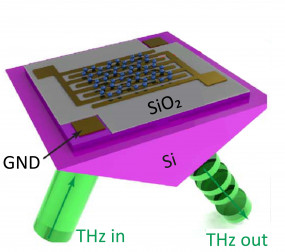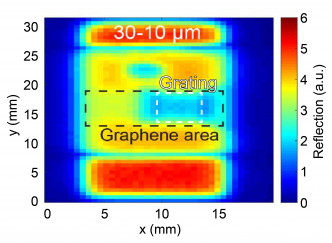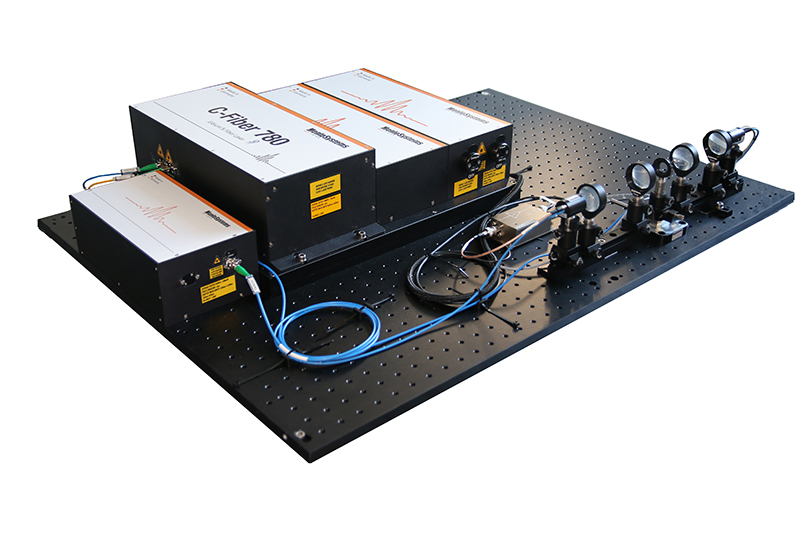Menlo Systems product:
Original publication:
A THz modulator for large-scale imaging arrays
The evanescent field in a graphene sheet covering a metal wire grating leads to efficient, broadband, and tunable THz modulation. The approach offers a viable technique for THz imaging via compressed sensing.
The advancement of THz applications such as communication and real-time imaging requires fast and efficient THz modulation. While existing devices lack of modulation depth, bandwidth, and speed, a group of Chinese, British, and American scientists observed substantial improvement of these attributes in their novel device. It consists of a subwavelength metal wire grating covered with a graphene sheet which is electrically contacted via the grating. Arranging the device in total internal reflection (TIR) geometry instead of transmission geometry proved to be a major contribution to the improvement. To study and optimize the underlying effect of nonresonant field enhancement in the wire grating and absorption in the graphene sheet, the group used Menlo Systems’ TERA K15 Terahertz Time-Domain Spectrometer.
Image reconstruction using electromagnetic modulators presents an efficient way to reduce costs and speed in THz imaging. Instead of a scanning device or THz antenna array, only one detector is needed. The design of broadband THz modulators with high modulation depth is therefore in the focus of the community, and a group of Chinese, British, and American scientists recently came up with a promising solution. They combined a low conductivity graphene sheet with a subwavelength metal wire grating, operated in total internal reflection (TIR) geometry. The outcome is an energy saving device with fast and broadband and high modulation depth (MD). The operation method relies on broadband electrical field enhancement within the gaps of the metal grating. In addition, applying a voltage to the graphene via the grating metal allows fast tuning of the MD. The arrangement in TIR geometry further lowers the required conductivity of the graphene and thus allows for achieving a high MD. With optimized grating parameters the group demonstrated a ~77% MD of the device in the frequency range of 0.2 – 1.4 THz.

Figure 1
While previous attempts for THz modulators were based on graphene only, the combined use of a metal wire grating brings significant improvement in the modulator MD performance. With the polarization of the THz wave chosen perpendicular to the grating direction, the subwavelength grating confines and enhances the electrical field within its gaps without absorbing it. In this regime, the enhancement factor (average electric field amplitude in the gap/incident electric field amplitude) η= P/g is optimized by tuning the grating parameters P (period) and g (gap width). The resulting high field intensity increases the absorption within the graphene and hence the MD of the device.
In their work, the researchers provide the first theoretical description of the field enhancement within the grating and the corresponding MD in TIR. Starting with the boundary conditions of the electromagnetic wave and using Snell’s law at a supercritical incidence angle, they find a reduction of the required graphene sheet conductivity for a given reflectivity by 1/η due to the wire grating. In the low sheet conductivity range, a small change of conductivity leads to a large variation of the THz reflection, meaning a high MD. The conductivity and therefore the reflectivity are tuned by applying a variable voltage to the graphene. Software simulations support the theoretical findings.
Figure 2
The team used Menlo Systems’ TERA K15 Terahertz Time-Domain Spectrometer to characterize the novel device. For measurements in TIR configuration, they placed the fabricated modulator on a Si prism (Fig. 1). The graphene sheet covered the area of the grating and a control area without grating for reference (rectangles in Fig. 2). The voltage applied to the grating electrode was swept from -60 V to +60 V. In TIR geometry the THz incident angle was 30° to the normal. Additionally, the group imaged the graphene device at normal THz incidence in reflection, with a THz polarization parallel and perpendicular to the grating direction (Fig. 2). The MD calculates from the voltage dependent attenuated intensity.
The THz images reveal a strong attenuation effect of the incident field in the area of the device graphene covered grating device, when the polarization of the THz field is perpendicular to the grating direction. The researchers attribute this to the field enhancement effect of the evanescent THz wave in the grating gaps and absorption into the graphene. They increase this effect by optimizing the grating parameters and by applying a voltage to the graphene via the grating. Control measurements with parallel polarization and in the area without grating corroborate the findings. The calculated MD is 4.5 times higher in TIR geometry if compared to a device without metal grating in transmission geometry over a broad spectral range. Combined into an array, such individually controllable grating blocks can serve as spatial modulator of a THz beam for single element detection. The high modulation speed of the device is a pathway towards real-time THz imaging.
Author: Patrizia Krok
Original publication:
Y. Sun et al.: Graphene-loaded metal wire gratings for deep and broadband THz modulation in total internal reflection geometry; Photonics Research Vol. 6, p. 1151 (2018)
